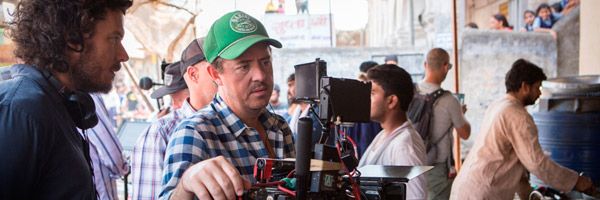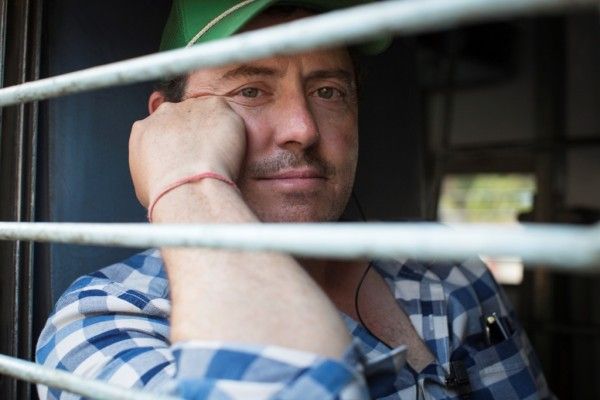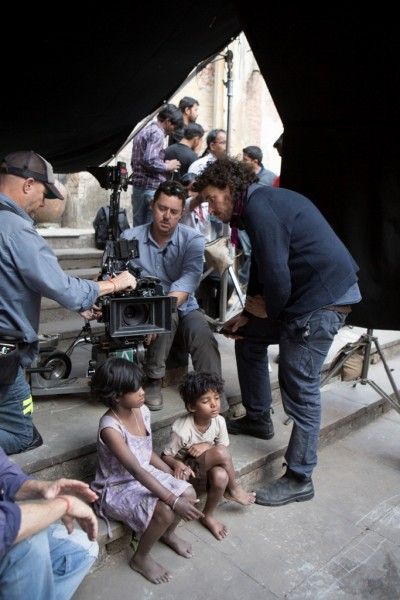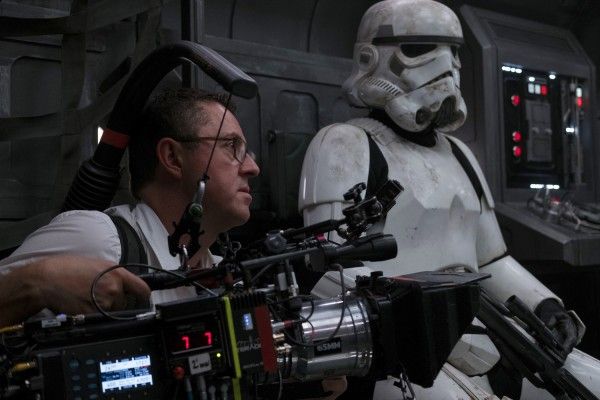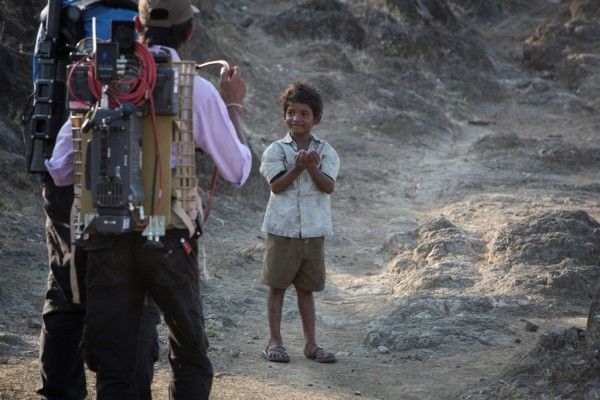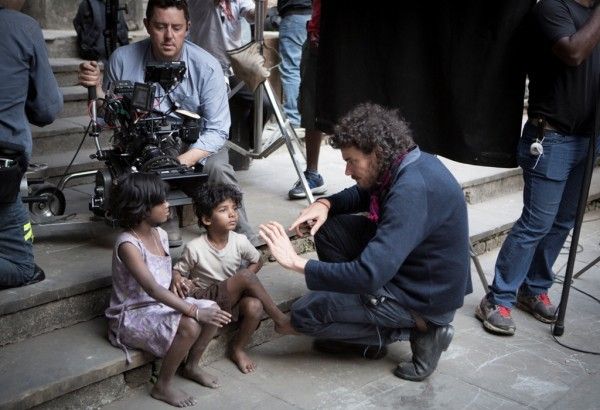Cinematographer Greig Fraser has been doing exciting work for years on films ranging from Bright Star to Zero Dark Thirty to Killing Them Softly. But 2016 was a banner year for Fraser, as it not only saw the release of both Lion and Rogue One: A Star Wars Story, but both films brought Fraser well-deserved acclaim. Lion has been an awards season contender for months, scoring six Oscar nominations including Best Cinematography, and Fraser won the American Society of Cinematographers’ top honor for his work on the emotional story of a man trying to find his home. And Rogue One notched swell reviews from critics and has grossed over $1 billion at the box office. So yeah, Greig Fraser had a good 2016.
Having been a fan of Fraser’s for some time now, I jumped at the chance to interview him as final voting for the Oscars is underway. During our exclusive conversation, he talked about the whirlwind year that he’s had, what came out of his early conversations with Garth Davis for Lion, and how his early hiring for Rogue One allowed him to test out some of that technology on the India shoot for Lion. We also discussed Fraser’s next collaboration with Davis, the Biblical drama Mary Magdalene starring Rooney Mara and Joaquin Phoenix. Fraser revealed that he shot the film with the Arri Alexa 65 and used entirely LED lights for the shoot, meaning we’re in for a treat when that one hits theaters. Check out the full interview below.
First of all congratulations on the ASC win and the Oscar nomination. What’s this experience been like for you with all this Lion stuff and then of course the Rogue One of it all.
GREIG FRASER: Yeah it’s pretty great. I mean obviously being Aussie I tend to try and downplay everything a little bit, I’ve been like ‘Yep, yep. It’s alright.’ And unfortunately I got into trouble with my wife, I think I was speaking to somebody the next day about the ASC Awards and I was going, ‘Yeah it’s good. Yeah.’ trying to be a little bit cool about it. She was like, ‘No, no, it’s bloody good!’ It’s cool. To be first of all nominated by your peers for the best film of the year in your category, and then to be awarded it I mean wow, what an amazing journey. And then the Oscar nom of course, the Academy is such a respected organization so to be nominated alongside those guys, my peers, my colleagues, the Linuses and the Bradfords and the Rodrigos and the James—I mean wow, what an honor. So yeah I’m sitting here quite buzzy and considering the fact that, Lion I’m nominated for that, but I did one of my favorite franchises, Star Wars, coming at the same time, I mean perfect year. I can’t top that year in terms of enjoyment.
It’s a little insane, and man the field this year of cinematography is so good.
FRASER: Isn’t it? And that’s the thing, I’m gonna go to the Oscars of course, and of course we’d all like to take home that trophy, but what I love about my colleagues is that we’re all kind of rooting for each other as well. We’re all really into each other’s work and what we can learn from each other and what we can teach other people. So I don’t know, I feel very honored just to be part of that really core group of humans that are doing that craft. And also for a film that I’m so passionate about, like Lion is such a passion of mine to have made. You know we made it on a shoestring and it’s such a great little story, and to work with someone like Garth who’s a really good buddy, my best mate, that we made this little film together and this little film has been really successful and a lot of people are seeing it. That’s the main thing, and the cherry on top’s the recognition for my craft.
Well Garth had obviously done tremendous work like Top of the Lake, but this was his first feature film. What were your early conversations about the film like?
FRASER: Well he told me the story and of course I went, ‘Wow’, and everything that I’ve always done with Garth I’ve always been really excited by, as in I’ve always been happy with. Now that goes from the early days of us doing a little $1,000 music video that he shot on Super 8 through to a documentary that we shot on mini-DV through to really high-end commercials for Xbox and other big brands. So every time Garth and I have ever worked together I’ve been particularly happy with the work that we’ve done together, as has he. So when we were talking about doing Lion, it was all a bit of a pipe dream in terms of we weren’t sure when it was going to film and we weren’t sure when the cast was gonna be ready, but in our initial conversations we were talking about how to best relay this story in a visual sense, because it’s got such strong overtones of Google Earth. Google Earth has become a little bit of an icon in our society. You get on maps and you wanna see what the quality of the road’s like, you go on Google Maps. Google Maps or virtual mapping had become such a staple of our daily lives that we couldn’t touch upon a film like that without then touching upon the visuals that go along with that. Given the fact that Google is an icon—not the company I’m talking about, very much I’m not talking about advertising the company I’m talking about the modern technology that they’ve brought to the show which is that visual mapping. So that had become such an icon that we needed to make sure that we touched on that and represented that without it all being just a simple map show. It’s not all about the maps, it’s about the people in those maps and the people in those stories. So yeah we wanted to come up with that balance between the humanity and the emotion as well as the epicness, that largeness.
For sure. Well obviously you followed Lion up with Rogue One, which is a very different kind of movie and a much larger scale. But I’m curious, is there anything you learned or hit upon in Lion that you took with you to Rogue One? Or is every movie just completely different?
FRASER: No they all influence each other. I was fortunate enough to test for Rogue One while I was just prepping Lion. This is the great thing about my friends over at Lucasfilm: They are so committed to the highest quality product that they allow their DPs to come on well in advance of the shoot. Often studios will go, ‘You’ve got 10 weeks of prep’, you’ll come in, you’ll tick the boxes and then you’ll start shooting. Lucasfilm, in their wisdom, they employed me about a year before we started filming so we were testing formats early. I knew about all these new formats that were coming down the pike like the 65mm, all this brand new LED technology, and I knew that it wasn’t quite ready. It wasn’t out, it wasn’t quite ready, I couldn’t do a film with it right now, but what I could do is I could go, ‘Hey guys if I chose this for Star Wars in a year’s time do you think it could be ready?’. And of course most of the suppliers went, ‘Uh yeah, I think we can make it ready for Star Wars.’ The good thing about that was I could then kind of test some of it for Lion. The perfect example is we had these LEDs that were kind of in the early stages of development, these digital sputniks they’re called, and I knew they were great and I knew they’d be amazing, so what I did is I went, ‘Listen I’m just gonna take them to India and do tests,’ because I knew they were gonna be amazing, but I ended up doing all of India with three small LEDs. Now we used a lot more of those on Rogue One because we had sets and stages and stuff, but the point is that the technology was just as at home in India as it was in a space station or a space ship or a set in a galaxy far, far away. So each film absolutely propagated each other. But the focus at that time of the year was doing Lion and making sure that we were able to properly shoot that emotion of that child and of the other characters, so trying to make sure that the technology never got in the way. To go back to your question they were very influential on each other, and even though you might look at them from a distance and go, ‘They’re very different movies’, actually the intention of the emotion’s similar. You want a similar level of emotion.
Well I know the reshoots angle on Rogue One has been covered to death, but I’m interested from a cinematographer’s perspective, what’s it like to go back after principal photography wraps? Is it tough to match the aesthetic and vibe that you hit upon in the first place?
FRASER: The thing is you always take into account—on a film of that scale, and in fact any film frankly, you expect to go back and do pickups. That’s a given. So you always take notes, you always shoot diagrams or understand what you were doing at the time so you know what you were doing, you know the equipment that you had. All of our sets on Rogue One they’re all DNX-controlled which meant that we had records of every single level, so you could literally put your lights where they were—you have diagrams of those—you could press “play” effectively, and the lights just go *bang* and they’re in the same level, same color and everything. I mean it’s not quite that easy—I wish it was but it’s not quite that easy, it takes a bit more effort than that, but effectively that’s the simple bones of it. So when you go back and do those things that you’re always expecting to do, it is quite a simple process and it’s not unexpected. It’s not like we show up on Day One of pickups and go, ‘Whoa, didn’t expect to be here again.’ No, we expected it, because that’s just the way filmmaking goes now. And it’s also been that way for years.
Yeah, it’s par for the course on a film of that scale now.
FRASER: Yeah. I mean any film, frankly. I would expect to do it on any film, even on Lion. We didn’t do any pickups on Lion anyway, but I would expect it so we took notes as if we were going to do that.
It makes sense. And it’s interesting because you’ve been in the midst of Lion’s release and awards and everything and all the while you and Garth have been shooting Mary Magdalene, which I’m really excited about. What can you tease people about that one?
FRASER: Well we shot on the Alexa 65mm for Mary Magdalene.
Oh wow.
FRASER: Yeah. We shot with some brand new lenses that Arri built for us and for our production for the shoot. I can tell you that we technically only used LED lighting on the film. We didn’t use any other lighting on the film, which was pretty interesting because it’s a period movie and it’s not a movie that you’d expect LED lighting to be useful for. It’s not a space movie, it’s not a modern film, it’s not a film at night in contemporary locations, it’s a period film where the lighting needs to be fire or daylight or moonlight or natural light, whatever it is, and we used all LED lighting on that too. I’m really excited about Mary Magdalene, it was wonderful working with Garth again. We unfortunately missed the premiere in New York and we were getting all these pictures and text messages from the premiere, I think it was the same screening that Bill Clinton went to, and we went ‘Awww, we’re missing it!’ But we went, ‘You know what? We’re making a movie. We’re about to film Rooney Mara and Joaquin Phoenix in a scene.’ I think it’s a pretty good tradeoff. It’s exciting, it’s exciting. It’s a beautiful film, I’ve seen some amazing performances—we got an incredible cast on Mary Magdalene. So I’m really excited, and I think Garth is a director to watch in my opinion. He has made an amazing film with Lion and he’s just gonna keep making amazing films, so I think we all need to back him up. Just back him up and be his rock.
Does the crucifixion play a role in the film? Did you shoot and craft a crucifixion scene?
FRASER: We did, we did. Obviously I shouldn’t talk too much about specifics, but there was a crucifixion scene yes.
It’s such daunting material, but obviously you’ve got a great cast and Garth is an exciting director, so I think that’s one that a lot of people are going to be looking out for.
FRASER: I think so, and also the fact that it’s a story that a lot of people know about too, but don’t quite know about this bent on the story. Of course I’m really excited about the script and the actors and the director, but technically I’m really excited for people to see it too because it’s a modest film but we made it with 65mm technology and beautiful lenses, and I think it’s beautiful man. It’s beautiful. I can’t wait for people to see it. The fact that it’s gonna be another however many months is kind of annoying because I want people to see it now.
Yeah I was already excited but the fact that it’s shot in 65mm makes me need to see it now.
FRASER: Yeah.
So what’s next for you? Do you know what your next project is yet?
FRASER: I’m talking to some people right now about some films. I’ve had a really fun two years doing Lion, Star Wars, and Mary Magdalene, I’m also a commercial shooter like I love doing commercials, so at the moment I’m sort of concentrating my time on doing commercials and reconnecting with a lot of commercial directors that I haven’t seen in a long time. I’m loving that, I’m loving being in L.A., I’m loving filming in L.A., like I shot last week with my good friend Derek Cianfrance who I haven’t had the chance to do a feature with yet. I did a commercial with him on film. This is the good thing about commercials is one week I’m working with Derek Cianfrance and the next week I’m working with another really good friend. On a film you work with somebody for four months and it’s wonderful, but commercials it’s like catching up with someone for a beer except you happen to shoot something at the same time.
That’s awesome. I love Derek’s work.
FRASER: Yeah, he’s amazing. He’s an amazing filmmaker.
Well thanks so much for talking to me today. I know you spoke with Steve in December so I appreciate you giving some more Collider love.
FRASER: Oh dude anytime, I love what you guys do. Literally. I read it a few times a week.
Oh thank you, that’s nice of you to say. We’ve got a pretty heavy cinephile audience so I enjoy highlighting the work of cinematographers and all the people involved in filmmaking beyond just the actors and the director.
FRASER: Totally. It’s a big audience because I just joined Instagram a few months ago and I’m just meeting all these great young DPs. There’s so many DPs out there, I just didn’t think the world had that many DPs. There’s young DPs, young artists, young photographers, and everybody’s really into each other’s stuff. It’s very fertile, and I see this through Instagram—I mean obviously you guys are seeing it through your readership—but there’s just a lot of people who wanna know how this stuff is done, and I think it’s amazing because that breeds extra creativity. If I can say something to somebody about how I did something and they’re like, ‘Oh awesome’ and they get an idea to do it a different way or that way but they add something to it, I can then go, ‘Wow somebody then shot with this camera but they shot with this particular lens package. What an amazing result. I never would’ve thought of that.’ So I can then grow from there, so for me it’s this beautiful fertile growth that I’m excited by.

